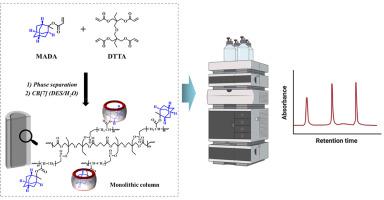当前位置:
X-MOL 学术
›
Anal. Chim. Acta
›
论文详情
Our official English website, www.x-mol.net, welcomes your feedback! (Note: you will need to create a separate account there.)
Construction of adamantane-based monolithic column with three-dimensionally porous structure for small molecules separation and biosample analysis
Analytica Chimica Acta ( IF 5.7 ) Pub Date : 2024-06-22 , DOI: 10.1016/j.aca.2024.342900 Wen Li , Chunli Gao , Yan Wang , Haiyue Zuo , Yangyang Bian , Cong Li , Shujuan Ma , Yehua Shen , Junjie Ou
Analytica Chimica Acta ( IF 5.7 ) Pub Date : 2024-06-22 , DOI: 10.1016/j.aca.2024.342900 Wen Li , Chunli Gao , Yan Wang , Haiyue Zuo , Yangyang Bian , Cong Li , Shujuan Ma , Yehua Shen , Junjie Ou

|
The fabrication technique of capillary column is the key to the development and application of capillary liquid chromatography (cLC) to improve separation efficiency for analytes. The capillary monolithic column possessed three-dimensionally connected porous or channel structures. Unique porous structure endows excellent permeability and high performance in diverse fields, especially in separation. Thereinto, organic monolithic columns have attracted widespread attention due to their advantages of simple preparation and excellent biocompatibility. However, their separation selectivity needs to be further developed and regulated to apply the separation of more diverse samples. A novel polymeric monolithic column was prepared thermally initiated copolymerization of 2-methyladamantan-2-yl acrylate (MADA) with ditrimethylolpropane tetraacrylate (DTTA) in fused silica. The prepared poly(MADA--DTTA) monolith showed adjustable permeability, developed porous structure and high thermal stability. Consequently, it exhibited excellent separation capability of small molecules (alkylbenzenes and polycyclic aromatic hydrocarbons). Especially, when acetonitrile/water (60/40, v/v) was used as the mobile phase, the theoretical plate numbers reached 84,000 plates m for butylbenzene at a linear velocity of 0.5 mm s. Most importantly, the hydrophobicity of the poly(MADA--DTTA) monolithic column was regulated host-guest interaction between adamantyl group and cucurbit [7]uril (CB[7]). Additionally, the poly(MADA--DTTA) monolith was further adopted for the analysis of the tryptic digest of proteins from HeLa by cLC-MS/MS. The 33,783 unique peptides and 5,299 proteins were identified on the monolith, which exhibited great separation ability for complex samples. Due to abundant pore structure and good chemical properties, the poly(MADA--DTTA) monolithic column exhibited high performance for the separations of small molecules and biological sample. Meanwhile, owing to the existence of adamantyl-group, CB[7] was immobilized on the poly(MADA--DTTA) monolithic column to fabricate poly(MADA--DTTA)-CB[7] by host-guest interaction. It is possible to adjust the surface chemistry of the monolithic materials to accommodate more complex analytes.
中文翻译:

用于小分子分离和生物样品分析的金刚烷基三维多孔结构整体柱的构建
毛细管柱的制备技术是毛细管液相色谱(cLC)发展和应用以提高分析物分离效率的关键。毛细管整体柱具有三维连接的多孔或通道结构。独特的多孔结构赋予其优异的渗透性和在不同领域(尤其是分离领域)的高性能。其中有机整体柱因其制备简单、生物相容性优良等优点而受到广泛关注。然而,它们的分离选择性需要进一步开发和调节,以应用于更多样化样品的分离。采用 2-甲基金刚烷-2-丙烯酸酯 (MADA) 与二三羟甲基丙烷四丙烯酸酯 (DTTA) 在熔融二氧化硅中热引发共聚制备了一种新型聚合物整体柱。所制备的聚(MADA--DTTA)整体材料具有可调的渗透性、发达的多孔结构和较高的热稳定性。因此,它表现出优异的小分子(烷基苯和多环芳烃)分离能力。特别是,当使用乙腈/水(60/40,v/v)作为流动相时,丁苯的理论塔板数在 0.5 mm s 的线速度下达到 84,000 塔板米。最重要的是,聚(MADA--DTTA)整体柱的疏水性受到金刚烷基和葫芦[7]脲(CB[7])之间的主客体相互作用的调节。此外,还采用聚(MADA--DTTA)整体通过 cLC-MS/MS 分析 HeLa 蛋白质的胰蛋白酶消化物。在整体上鉴定出 33,783 个独特的肽和 5,299 个蛋白质,对复杂样品表现出强大的分离能力。 由于丰富的孔隙结构和良好的化学性质,聚(MADA--DTTA)整体柱在小分子和生物样品的分离中表现出高性能。同时,由于金刚烷基的存在,将CB[7]固定在聚(MADA--DTTA)整体柱上,通过主客体相互作用制备聚(MADA--DTTA)-CB[7]。可以调整整体材料的表面化学以适应更复杂的分析物。
更新日期:2024-06-22
中文翻译:

用于小分子分离和生物样品分析的金刚烷基三维多孔结构整体柱的构建
毛细管柱的制备技术是毛细管液相色谱(cLC)发展和应用以提高分析物分离效率的关键。毛细管整体柱具有三维连接的多孔或通道结构。独特的多孔结构赋予其优异的渗透性和在不同领域(尤其是分离领域)的高性能。其中有机整体柱因其制备简单、生物相容性优良等优点而受到广泛关注。然而,它们的分离选择性需要进一步开发和调节,以应用于更多样化样品的分离。采用 2-甲基金刚烷-2-丙烯酸酯 (MADA) 与二三羟甲基丙烷四丙烯酸酯 (DTTA) 在熔融二氧化硅中热引发共聚制备了一种新型聚合物整体柱。所制备的聚(MADA--DTTA)整体材料具有可调的渗透性、发达的多孔结构和较高的热稳定性。因此,它表现出优异的小分子(烷基苯和多环芳烃)分离能力。特别是,当使用乙腈/水(60/40,v/v)作为流动相时,丁苯的理论塔板数在 0.5 mm s 的线速度下达到 84,000 塔板米。最重要的是,聚(MADA--DTTA)整体柱的疏水性受到金刚烷基和葫芦[7]脲(CB[7])之间的主客体相互作用的调节。此外,还采用聚(MADA--DTTA)整体通过 cLC-MS/MS 分析 HeLa 蛋白质的胰蛋白酶消化物。在整体上鉴定出 33,783 个独特的肽和 5,299 个蛋白质,对复杂样品表现出强大的分离能力。 由于丰富的孔隙结构和良好的化学性质,聚(MADA--DTTA)整体柱在小分子和生物样品的分离中表现出高性能。同时,由于金刚烷基的存在,将CB[7]固定在聚(MADA--DTTA)整体柱上,通过主客体相互作用制备聚(MADA--DTTA)-CB[7]。可以调整整体材料的表面化学以适应更复杂的分析物。











































 京公网安备 11010802027423号
京公网安备 11010802027423号